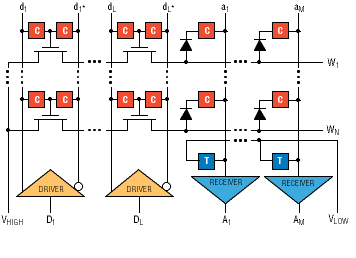Solid-state storage patent promises
CD-ROM density without moving parts
A recently issued patent, “Integrated Content Addressable Read
Only Memory (CAROM),” describes a data storage system that promises
CD-ROM density in an arbitrarily shaped package without moving parts. The
scheme, along with a data-compression algorithm called Autosophy, claims
to need only logarithmically increasing size to store a linearly increasing
database.
In linear data storage, such as a CD-ROM, storage requirement increases
linearly with data volume. In Autosophy data storage, previously learned
data is reused to compress new data input. The more memory that is already
stored in the CAROM, the less additional memory required to store further
data.
As with any solid-state memory, this scheme consists of an array of
identical cells, logically arrayed in rows and columns (see diagram ).
The input-data drivers produce complementary signals d and d/ in each data
column. The squares “C” contain the stored information by being
either open or closed connections. Thus a FET will conduct or not when
its data line is driven, according to which of its associated cells is
closed.

In the CAROM technology, an expandable array like this produces
a unique address for each stored data word, without requiring additional logic.
All of the FETs in a row are in series, so they form an AND of all the
bits in the row. When a row goes high, an address line is driven if the
cell in series with its diode is closed. Depending on the application,
the cell element could be a fusible link, a floating-gate transistor, or
any other switching element.
On a silicon chip, this would just be another way of making a content-addressable
memory, but the company expects to etch these arrays on foil, in the manner
of active LCD production. This could result in foldable devices, with many-megabyte
capacities, that fit in PC Cards or other small cartridges.
The Autosophy algorithms guarantee that only one row can be made active
by any input-data word. This makes the power consumption independent of
the size of the array. The algorithms also guarantee that no more than
one of a complementary pair of fuse cells be made conductive. Response
time is also relatively insensitive to size, since power is applied to
all rows at the same time.
Input data lines can be used for cascading device addresses, as well
as for a clock that unblocks the device only when the other inputs have
settled. Redundant rows and columns will alleviate the requirement for
perfect arrays, which is still a problem for display manufacturers.
The patent does not disclose the programming algorithms, but does say
that the algorithms can merge data sets and avoid “learning”
what is already known. Thus duplicate data words are combined, producing
only one output.
This appears to be the basis for the claim of logarithmic space requirement.
For more information about the CAROM and Autosophy algorithms, call Diana
Kalienky of Omni Dimensional Networks at 415-834-1646, e-mail ,
visit , or circle 492.
–Rodney Myrvaagnes
Advertisement





